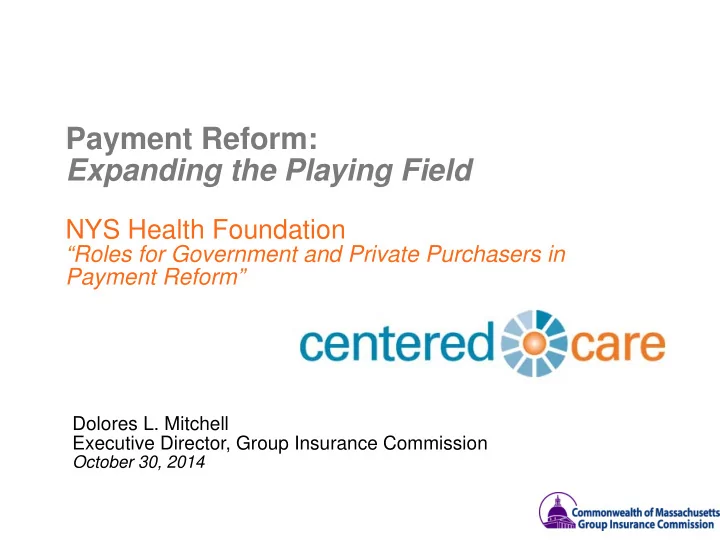

Payment Reform: Expanding the Playing Field NYS Health Foundation “Roles for Government and Private Purchasers in Payment Reform” Dolores L. Mitchell Executive Director, Group Insurance Commission October 30, 2014
Out on a Limb – That’s Where the Fruit Is
Watch Out! The GIC is Going Out on a Limb
The Triple Aim • Better health care • Better population health • Lower per capita cost Don Berwick, Former Administrator, Centers for Medicare & Medicaid Services
Now for the How
What Were We Trying to Achieve? Market Change • Five year contracts – Reducing cost growth and then actually reversing it • Align GIC’s strategy with federal and state payment reform • Reimburse providers based on value rather than volume – Health Plans move from Fee for Service (FFS) contracts with providers, to global budgets for the management of care • Impose penalties on Plans for missing spending targets, or share savings for beating targets – Gains and losses to be shared with providers 5
Control Costs Over Multiple Years: Fiscal Implications $2.01B $2.01B Status quo Status quo (6.0% avg. (6.0% avg. costs costs trend) trend) Cumulative Cumulative savings of $1.29B savings of $1.29B If costs come in 2% worse than If costs come in 2% worse than target goals, including penalties target goals, including penalties due to provider due to provider paid to the GIC paid to the GIC payment reform payment reform Reflects achievable Reflects achievable costs under provider costs under provider $1. 61B $1. 61B payment reform payment reform (1.4% avg. (1.4% avg. trend) trend) $1.49B $1.49B (-0.1% avg. (-0.1% avg. $1.5B $1.5B trend) trend) If costs come in 2% better than financial If costs come in 2% better than financial $1.39B $1.39B goals, including bonus paid to plans goals, including bonus paid to plans (-1.6% avg. (-1.6% avg. trend) trend) FY13 FY13 FY13 FY13 FY14 FY14 FY14 FY14 FY15 FY15 FY15 FY15 FY16 FY16 FY16 FY16 FY17 FY17 FY17 FY17 FY18 FY18 FY18 FY18
What Are We Trying to Achieve? Improved Care Delivery • Drive system transformation Health Management Health Management Health Management Hospital System Hospital System Hospital System System System System Physician-Hospital Physician-Hospital Physician-Hospital Hospital Hospital Hospital Co-dominance Co-dominance Co-dominance Dominance Dominance Dominance Continuum Care Continuum Care Continuum Care Fragmented care Fragmented care Fragmented care ALOS = 365 days ALOS = 365 days ALOS = 365 days ALOS = 3.65 days ALOS = 3.65 days ALOS = 3.65 days (Hosp=Cost Center) (Hosp=Cost Center) (Hosp=Cost Center) Hosp=Profit Center Hosp=Profit Center Hosp=Profit Center 2015 2015 Physician driven Physician driven Physician driven Protocol-driven Protocol-driven Protocol-driven care care care “Team Care” “Team Care” “Team Care” Process Process Process Outcome Outcome Outcome measures measures measures measures measures measures Best=most expensive Best=most expensive Best=most expensive Best = most effective Best = most effective Best = most effective care care care at lowest cost at lowest cost at lowest cost Per service Per service Per service Risk-adjusted Risk-adjusted Risk-adjusted Payment Payment Payment Outcome Pmnt Outcome Pmnt Outcome Pmnt • Encourage Primary Care Provider (PCP) assignment, to increase care coordination and quality – Health plan communications to members confirming PCP elections – “Know your numbers” (biometrics) and “know your doctor” marketing campaigns 7
What We Learned Through the RFP Process • All plans already measure quality and consumer satisfaction to some degree --- BUT • They are not currently organized in a way that enables them to change care delivery • Health care providers must redesign care coordination models • Purchaser Initiatives have helped but can’t do the job alone - Patient Centered Medical Homes, Clinical Performance Improvement (CPI) Initiative, Leapfrog, Catalyst for Payment Reform, Pay for Performance, Bridges to Excellence • All plans need to re-negotiate contracts with providers to meet the GIC’s strategy goals • Members have to be brought into the solution by taking care of their health and working with their Primary Care Providers 8
What Does This Mean in Practice to the Patients? - 10 Key Elements 1) PCP designation 6) High level of care for chronically ill 2) PCP engagement 7) Disease management 3) Data sharing 8) Group visits 4) Low cost providers encouraged 9) Transitional care management 5) Expanded hours and urgent care 10)Essential reporting package access
Who? Who?
Recommend
More recommend